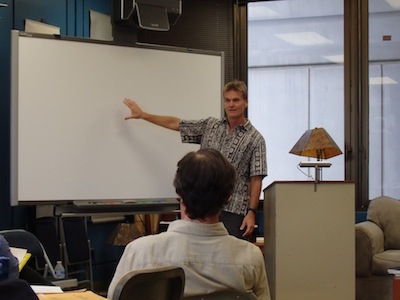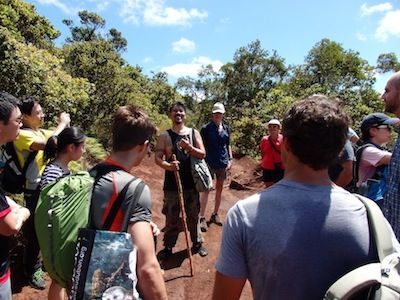[Report] UT-UH Summer Institute for Comparative Philosophy 2014 (4)
On 10th August, we had the first keynote lecture by professor Peter Hershock from University of Hawai'i, at Manoa. The next day, we went for the Halapepenui Trail hike with Dr. Sam Gon III. In this blog, these lecture and activity are reported by Ms. Yui Fujita.
The lecture by Prof Peter Hershock
After tropical storm Iselle had passed over the island of Oahu, we attended our first keynote lecture given by Peter Hershock, entitled “Enlightenment Taking Place: Intimations of a Situated Ethics of Diversity”. In this lecture, Dr. Hershock connected Buddhist philosophy and practice to his thoughts on place and justice.
Being new to Buddhist philosophy and practice, the most striking aspects of Dr. Hershock’s lecture for me was how it challenged broadly-speaking “Western” ideas about truth and falsehood, the individual, and relations. Firstly, drawing on Dogen, Dr. Hershock explained that truth and falsehood were, for Dogen, not absolute opposites but rather a sliding scale with truth at one end and falsehood at another. Furthermore, relations between people are primary, with the concept of an individual being an abstraction that comes after the fact. He also mentioned the philosophy of the Huayan school of Buddhism (as elucidated by Fazang) – that all things are related, all things have an effect on each other, all things have their meaning and differ from each other due to the relation that they are in with respect to each other. Through such explanations Dr. Hershock advocated a nondualism which realizes diversity rather than erases differences. Finally, such a nondualism was connected to justice through the notion of kusala – justice being the shared practice of fostering kusala actions (i.e. actions that promote good outcomes within the network of relations in which one is placed) and thus being attentive and responsive to those relations. As Dr. Hershock explained, since the place where one achieves enlightenment just is the place one is, one starts and can only start on such a path there.
In conclusion, Dr. Hershock’s lecture was a great introduction to Buddhist thought and a challenge to traditional “Western” liberal notions of the individual and society. By presenting us with an alternative way of thinking, he offered us another way to conceive of our selves, our ‘place’ and how we relate to it.
The Halapepenui Trail hike
Students and teachers gathered early in the morning on August 11th to take part in the Halapepenui Trail hike with Dr. Sam Gon III. The trail, now private property and therefore usually closed to the public, is named for the halapepe plant which grows along it. Bags packed with lunch and water, we began our hike along path of bright red soil tucked away behind a gate in a quiet residential district of Oahu. Our hike took us from the wao kanaka (the realm of people’s daily lives) up to the wao akua (the sacred realm where the spirits dwell).
Every once in a while, Dr. Gon would pause to show us certain plants or give us brief explanations about their names and their history. One example was the akia plant, poisonous to fish, which was used by native Hawaiians to catch fish to use as bait on the open seas. Another was the strawberry guava, which originated in Brazil but which, once it took root in Oahu, proved so hardy that it began to overtake endogenous and native plants. Through this and other examples, we learned about how very few plants along the trail were endogenous to (originated in) Oahu and about how delicate the balance within an ecosystem is. Other plants to which our attention was drawn included uluhe (symbol of the goddess Hina), koa, pala`a, and sandalwood (a tree which has great significance in the history of Hawaii). Along the way, we were even treated to a view of Pearl Harbour. The further we went, the narrower and pricklier our path became until finally, we reached our lunch spot, relatively high up on a ridge. As Dr. Gon explained, to hike the whole trail would have taken much longer than our time allowed, so after lunch, we hiked back along the path we had come until we reached the gate again. After a well-earned rest, some ice-cream and/or shave-ice, and lots of water at Dave’s Ice Cream nearby, we returned to UH Manoa.
All in all, the day provided us with an insight into the complex history of the Hawaiian (and more broadly, Polynesian) islands, as well as how ecology is, and always has been, intertwined with the lives of human beings. As Dr. Gon mentioned, now that the human impact on the environment has become so pervasive, we can no longer simply say, ‘let nature take its course’. As active shapers of the environment, we must think more deeply about the ways in which we might mitigate or avoid the harmful effects our actions may have on out surroundings.
Yui Fuijita (University of Tokyo)








